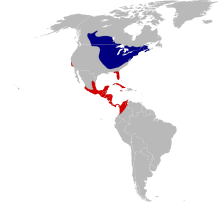
Icterids or New World blackbirds make up a family, the Icteridae, of small to medium-sized, often colorful, New World passerine birds. The family contains 108 species and is divided into 30 genera. Most species have black as a predominant plumage color, often enlivened by yellow, orange, or red. The species in the family vary widely in size, shape, behavior, and coloration. The name, meaning "jaundiced ones" comes from the Ancient Greek ikteros via the Latin ictericus. This group includes the New World blackbirds, New World orioles, the bobolink, meadowlarks, grackles, cowbirds, oropendolas, and caciques.

The Altamira oriole is a New World oriole. The bird is widespread in subtropical lowlands of the Mexican Gulf Coast and northern Central America, the Pacific coast and inland. They have since spread to southern Texas, but this was not until 1939.

The red-breasted sapsucker is a medium-sized woodpecker of the forests of the west coast of North America.

Bullock's oriole is a small New World blackbird. At one time, this species and the Baltimore oriole were considered to be a single species, the northern oriole. This bird is named after William Bullock, an English amateur naturalist.

The orchard oriole is the smallest species of icterid. The subspecies of the Caribbean coast of Mexico, I. s. fuertesi, is sometimes considered a separate species, the ochre oriole or Fuertes's oriole.
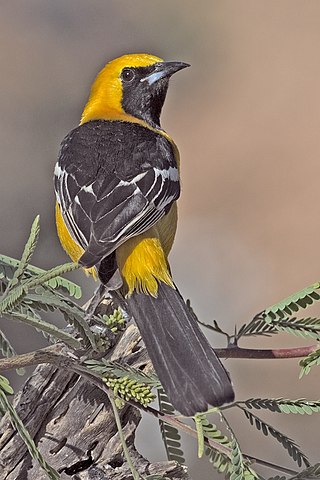
The hooded oriole is a medium-sized New World oriole. The male of this species ranges in color from a bright orange to a paler yellow, with a black back, face, tail and bib, with the wing containing two white bars. The female is more of an olive color with some yellow accents.
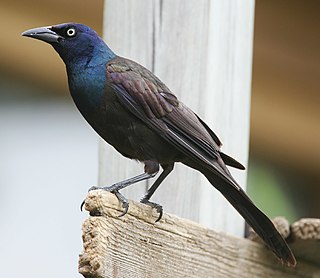
The common grackle is a species of large icterid bird found in large numbers through much of North America. First described in 1758 by Carl Linnaeus, the common grackle has three subspecies. Adult common grackles have a long and dark bill, pale yellow eyes, and a long tail. Adults often have an iridescent appearance on their head, especially males. Common grackles can be found widely across North America east of the Rocky Mountains.

The yellow-rumped warbler is a regular North American bird species that can be commonly observed all across the continent. Its extensive distribution range connects both the Pacific and Atlantic coasts of the U.S. as well as Canada and Central America, with the population concentrating in the continent's northern parts during the breeding season and migrating southwards to southern North and Central America in Winter. The species generally prefers coniferous forests or mixed coniferous-deciduous forests as its breeding habitat, while during the winter it can be found inhabiting more open areas such as shrublands that offer food resources. The diet of the yellow-rumped warbler is based primarily on insects, though the species does eat fruits such as juniper berries as well, especially in winter.

The American redstart is a New World warbler. It is unrelated to the Old World (common) redstart.
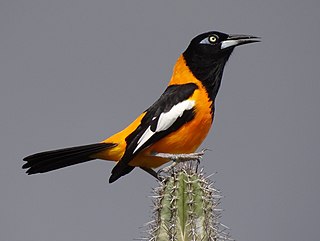
The Venezuelan troupial is the national bird of Venezuela. It is found in Colombia, Venezuela, and the Caribbean islands of Aruba, Curaçao, Bonaire, Trinidad, and Puerto Rico. Together with the orange-backed troupial and campo troupial, it was previously part of a superspecies simply named the troupial that was split.

The black-headed grosbeak is a medium-sized, seed-eating bird in the family Cardinalidae. It is sometimes considered conspecific with the rose-breasted grosbeak with which it hybridizes on the American Great Plains.

The yellow-tailed oriole is a passerine bird in the New World family Icteridae. It breeds from southern Mexico to western Peru and northwestern Venezuela; in Peru it also lives in a river valley corridor.

Audubon's oriole, formerly known as the black-headed oriole, is a New World passerine inhabiting the forests and thickets of southeastern Texas and the Mexican coast. It is the only species to have a black hood and yellow body. It is divided into four subspecies and two allopatric breeding ranges. The westernmost range extends from Nayarit south to southern Oaxaca, whereas the eastern range stretches from the lower Rio Grande valley to northern Querétaro. The most common in the western range are the subspecies I. g. dickeyae and I. g. nayaritensis; I. g. graduacauda and I. g. audubonii can be found in the eastern range. Like most Central American birds, it is not a migratory species and does not display significant sexual dimorphism. DNA analysis of the ND2 and cyt-b genes strongly suggests that I. graduacauda is most closely related to I. chrysater, the yellow-backed oriole. It is a member of the genus Icterus and therefore should not be confused with the Old World orioles.

The oriole blackbird is a species of bird in the family Icteridae. Its genus, Gymnomystax, is monotypic. It is a medium-sized yellow and black bird found in Brazil, Colombia, Ecuador, French Guiana, Guyana, Peru, Suriname, and Venezuela, where its natural habitats are subtropical or tropical moist lowland forest, subtropical or tropical moist shrubland, subtropical or tropical seasonally wet or flooded lowland grassland, and swamps.

The orange oriole is a small bird species with orange feathers native to the Icteridae family in the Yucatán Peninsula. It has a slender body, long wings, and a pointed beak. Its color resembles the fruit orange, and it has black markings on its wings and tail. The orange oriole is known for its song and can be found in forests and gardens. They have a diverse diet that contributes to their color. According to The Cornell Lab of Ornithology Birds of the World, they have suggested that this species might be better named the “Yucatan Oriole” because they are only found in Southeast Mexico. This species is not endangered and least threatened.

The yellow-backed oriole is a species of bird in the family Icteridae.

The Saint Lucia oriole is a species of bird, in the family Icteridae and genus Icterus. It is endemic to Saint Lucia.
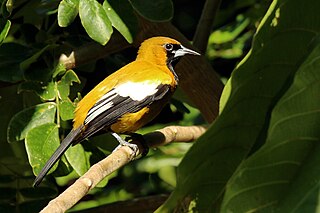
The Jamaican oriole is a species of bird in the family Icteridae.
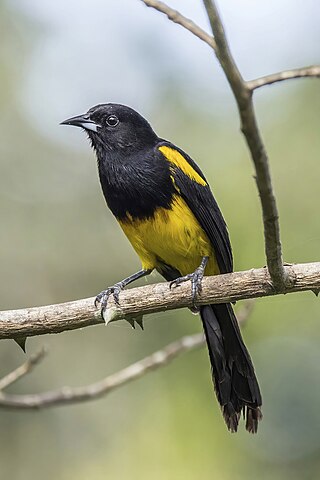
The black-cowled oriole is a species of bird in the family Icteridae. It is common and widespread in the Caribbean lowlands and foothills from southern Mexico to western Panama. It lives primarily in humid or semihumid forest, as well as in clearings, along forest edges, in plantations, in semi-open areas with scattered trees and bushes, and in gardens. The adult male is black, with yellow on the belly, shoulder, rump, wing lining, and crissum. The female's plumage varies depending on location. In the south of its range, it is similar to that of the male. In the north, its crown and upperparts are olive-yellow, while its face, throat, upper breast, wings, and tail are black.
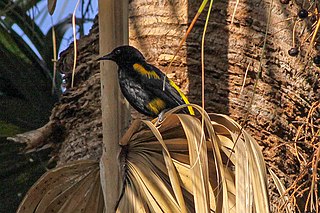
The Hispaniolan oriole is a species of bird in the family Icteridae. It is endemic to the Caribbean island of Hispaniola.

